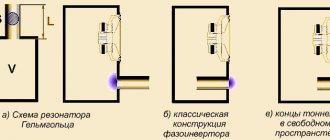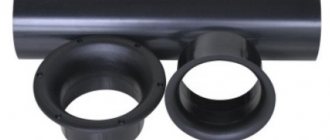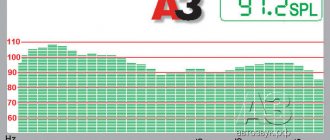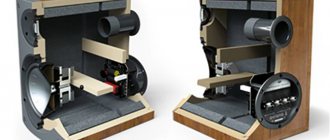Bass reflex is not on paper
Such problems arise among children, adults and oligarchs. The first ones are asked, the second ones are on fire, the third ones control. All these can be solved using known methods; we will go further.
The logical ending to the saga of the bass reflex will be the practical aspects of its implementation. The key element here is precisely the pipe, which is also a tunnel, which, as a result of slavish transliteration from English, is also a port. It is this, the pipe, that will make it possible to implement in practice two main parameters that determine the acoustic appearance of the conceived bass reflex: the volume of the housing and its tuning frequency. These two values, one in liters, the second in hertz, are the result of either an independent calculation or following previously made calculations. Their source may be the speaker manufacturers, our tests, or expert advice based on their practice. In all three cases, it happens that ready-made tunnel dimensions are given, ensuring the tuning of a known volume to the desired frequency, but, firstly, not every time, and secondly, blind copying is not always possible and is always not commendable. So the following formulation of the problem will be more general and much more productive: the volume and frequency are known, and we will solve the question of their physical, material, implementation on our own. Part of the story will be organized according to the principle of questions and answers: the nomenclature of questions is known, in the editorial mail they are repeated with regularity, giving rise to statistical calculations that our testing department loves so much. I won’t take away their favorite toy, or ours. So, what first, do we calculate the tunnel or buy the pipe that will become this tunnel? In theory, you need to buy it first - the pipes do not come in any diameter, but from a certain range of values, if you take ready-made ones, and do not wind them yourself from paper with glue, like a pioneer from a young cosmonaut's circle. But you still have to start with at least a rough estimate, and the point here is that...
Thickness matters
If the tunnel is really a pipe (there are options, after all), what diameter should it be? The most general and crudest answer is: the more, the better. The advice is really radical and can cause a protest reaction: what if I take and make a tunnel with a diameter twice the size of the speaker? You won’t take it and won’t do it, no matter how hard you try, this was taken care of more than a hundred years ago by a certain Hermann Helmholtz, whose resonator name the bass reflex is, and later by the creators of cars, who made them smaller in size than the steam locomotives that existed at that time. So, in order, why more and why something will stop this process.
On the issue of thickness: pushing the same volume of air through a tighter tunnel, it will have to be accelerated to a higher speed. And “speed is death”
During operation near the tuning frequency, where, in fact, the bass reflex tunnel performs its functions, adding to the sound waves generated by the vibrations of the diffuser, air moves inside the tunnel. It moves oscillatingly, back and forth. The volume of moving air is exactly the same as that driven by the diffuser during each oscillation; it is equal to the product of the diffuser area and its stroke. For a tunnel, this volume is the product of the cross-sectional area and the air flow inside the tunnel. The cross-sectional area is actually always smaller than the diffuser area (if anyone has not yet given up the threat to make the same, or even larger, they will soon not go anywhere and refuse), and in order to move the same volume, the air needs to move faster, the speed in the tunnel decreases diameter increases in proportion to the decrease in its cross-sectional area. Why is this bad? Everyone at once. First of all, the Helmholtz resonator model, on which everything is based, assumes that there is no energy loss due to air friction against the tunnel walls. This, of course, is an ideal case, but the further we move away from it, the less the bass reflex operation will resemble what we expect from it. And the higher the air speed inside the tunnel, the higher the friction losses in the tunnel. Theoretically, the formula, and even the simple program based on it, does not take these losses into account and will meekly give you the estimated length of the tunnel with a diameter of even a finger, but such a bass reflex will not work, everything will die in the turbulence of the air trying to quickly fly backwards through the tight tunnel. forward. The text of a traffic police propaganda poster I once saw, “Speed is death,” certainly applies to the movement of air in a tunnel, if death is attributed to the effectiveness of the bass reflex.
Helmholtz would have written his formula in exactly the same way, but there was no photographer at that moment
However, much before the phasic dies as a means of sound reproduction, it will become a source of sounds for which it is not intended; vortices arising from excessively high air speeds will create jet noise that disrupts the harmony of bass sounds in the most unscrupulous and unaesthetic way.
The final and actual formula replacing the computer program. It is correct, it has been checked several times. The meaning of the “tail” highlighted in red will be explained in the text
What should be taken as the minimum cross-sectional area of the tunnel? You will find different recommendations in different sources, not all of them have ever been tested by the authors, even through a computational experiment, let alone others. As a rule, such recommendations include two values: the diameter of the diffuser and the maximum value of its stroke, that is, Xmax. This is reasonable and logical, but it fully applies only to the operation of the subwoofer at the maximum mode, when it is already a little late to talk about sound quality. Based on numerous practical observations, you can adopt a much simpler rule; it is flawed and not entirely universal, but it works: for an 8-inch head the tunnel must be at least 5 cm in diameter, for a 10-inch head - 7 cm, for a 12-inch -ti and more - 10 cm. Is it possible more? It’s even necessary, but right now something will stop us. Namely, the length of the tunnel. The fact is that…
Length matters
As was said, she will be commanded by the great Hermann von Helmholtz. Here he is, at the blackboard at the University of Heidelberg, and on the blackboard is the same formula. Well, okay, this time I wrote it, but I made it up - he would have written it exactly the same way. This simple dependence, since it was derived for the ideal case, shows what the resonance frequency of a certain cavity will be (we are more familiar with a box, although Hermann von made some kind of bubbles with pipe tails) depending on the volume V, length L and cross-sectional area of the tail. Please note: there are no speaker options here, and it would be strange if there were. In any case, it is useful to remember and never succumb to provocations: the bass reflex setting is completely and exhaustively determined by the size of the box and the characteristics of the tunnel connecting this box with the environment. In addition, the formula includes only the speed of sound in the atmosphere of planet Earth, designated “c,” and the number “pi,” which does not even depend on the planet.
Could the tunnel be outside the box? Yes, a whole company built its business on this, the patent for an easy-to-place subwoofer was replicated by hundreds of thousands of SAS Bazooka bass tubes. And manufacturers of built-in subwoofers for home theaters don’t give a damn...
For practical purposes, namely, calculating the length of the tunnel from known data, the formula can be easily transformed by remembering your native school, and the constants can be substituted in the form of numbers. Many people did this. Many people published the results of this exciting process, and the author is a little surprised how it was possible to screw up spectacularly during an operation with three or four numbers. In general, a third of the converted formulas published on paper and on the Internet are incomprehensibly nonsense. The correct one is given here if you substitute the values in the units shown in black.
The same formula, plus some corrections, is included in all known programs for calculating bass reflexes, but right now the formula is more convenient for us, everything is in sight. Look: what will happen if, instead of the minimalist tunnel, we install another, larger (and therefore better) one? The required length will increase in proportion to the square of the diameter (or in proportion to the area, but we were going to buy a pipe by diameter, they don’t sell it any other way). We switched from a 5-centimeter pipe to a 7-centimeter one, for example, the length with the same setting will need twice as much. We moved to 10 cm - four times. Trouble? So far, it’s not so bad. The fact is that…
Caliber matters
There will be trouble now. Let’s look at the formula again, this time look at the denominator, focus your vision. All other things being equal, the length of the tunnel will be greater, the smaller the volume of the box. If, in order to tune a 100-liter volume to 30 Hz, having a 100-mm plumbing pipe at your disposal, you need to open and paste a 25-centimeter piece of shit pipe into the box, then with a box volume of 50 liters it will be half a meter (which is no less, than not so bad), and with the fairly common 25 liters, a tunnel of this thickness will have to be a meter long. This is already a disaster, there are no options.
Is it possible to leave the tunnel inside, but bend it as it is more convenient? Here's your answer
In our practical conditions, the volume of the box is primarily determined by the parameters of the speaker, and for reasons already well known to readers of this series, for 8-inch heads the optimal volume rarely exceeds 20 liters, for “ten” heads - 30 - 40, only when it comes reaches 12-inch caliber, we begin to deal with volumes of the order of 50 - 60 liters, and even then not always.
So we get some kind of parade of sovereignties: the FI tuning frequency is determined by the bass that we want to get from it, whether it’s on the “eight” or on the “fifteen” - it doesn’t matter. And the tuning frequency of the box again does not depend on the speaker; the smaller the volume, the longer the tunnel. The result of the parade: as we have repeatedly noticed in tests of small-caliber subwoofers, the desired and promising design option in FI is physically impossible (or difficult) to implement. Even if you don’t mind the space in the trunk, you cannot make the volume of the FI box larger than the optimal one, and the optimal one often turns out to be so small that setting it to a frequency of 30 - 40 Hz, which is invariant to other factors, is unthinkable. Here is an example from a recent test of 10-inch subwoofer heads (“A3” No. 11/2006): if we take a pipe diameter of 7 cm as an axiom, then in order to make a bass reflex on the Boston head, a piece of it 50 cm long would be needed, for Rainbow - 70 cm, and for Rockford Fosgate and Lightning Audio - about a meter. Compare with the recommendations in the test of this issue relating to 15-inch heads: none of these problems were noted. Why? Not because of the speaker, as such, but because of the initial volume selected according to the speaker parameters. What to do? Meet adversity head-on. Generations of specialists (and others) forged our weapons. Do you know what's the matter?
Shape matters
You could hardly fail to notice: I really like to delve into patents, because I believe that even though the road from invention to real life is not so short, a patent is a reflection of thought in the form of a vector, that is, taking into account the direction. Most of the innovations proposed (and steadily proposed) by tireless minds in relation to the bass reflex are concentrated on combating two interfering factors: the length of the tunnel, when its cross-section is large, and jet noise, when they tried to reduce its cross-section, trying to reduce the length. The first, simplest solution, the admissibility of which we are asked in our editorial mail about five times a month: is it possible to place the tunnel not inside the box, but outside? Here is the answer, final, factual and real, like a paper for Professor Preobrazhensky’s apartment: you can. At least partially, at least entirely, the tunnel was pushed inside the box solely for aesthetic reasons; von Helmholtz had it sticking out outside, and nothing, he survived it. And our modern times provide examples: for example, car audio veterans cannot help but remember (many, frankly speaking, cannot forget) the “bass pipes” of the SAS Bazooka company. They started with a patent for a subwoofer that could be conveniently placed behind the seat of a truck, America's favorite vehicle. To do this, the inventor stretched the bass reflex pipe along the body from the outside, at the same time giving it a shape spread out over the surface of the cylindrical body. This is one example, there is another: some companies that produce built-in subwoofers for home theaters bring out a pipe-tunnel of a bandpass subwoofer. The type of subwoofer in this case does not matter: it is the same resonator named after you know who. Judging by the letters, they are also looking for another solution, but they are afraid. “Is it possible to bend a tunnel?” The answer is in the style of Philip Philipovich and is obvious. Otherwise, several companies (DLS, JL Audio, Autoleads, etc. etc.) would not have produced flexible pipes specifically for this purpose. And in the field of patent documentation there is even an interesting hint on how this problem can be solved not without grace and material savings: at one time a design was proposed for a model tunnel that would be assembled from standard elements in any desired form; the illustration will tell the rest. I’ll add on my own behalf: most of the details depicted in the patent are touchingly reminiscent of the nomenclature of elements of local sewer networks, which is a practical recipe for introducing the intellectual excess of the American inventor.
Exotic, desperate solutions: roll up the tunnel with a spiral or screw
When struggling with the inappropriate length of the tunnel, they often take the path of constructing so-called “slot ports”, their advantage lies in their structural integration with the body, which allows, with a certain imagination, to make the tunnel quite long; in the attached diagram there are several options at once, which the question is, Of course, it is far from being exhausted (the three top sketches belong to the pen of the famous high-end designer Alexander Klyachin, the rest was a matter of technique).
The disadvantage of the slots is that it is difficult to adjust the length, this is not plumbing PVC - waved the saw, and it was done. But there are solutions here too: not so long ago, one of the heroes of the “Own Game” column, Permian Alexander Sultanbekov (it’s not a sin to once again remind the country of the names of its heroes) demonstrated in practice how a slot port can be adjusted by changing its cross-section while maintaining a constant length, he I did it by placing plywood spacers inside, as shown in the photo somewhere nearby, look for it.
The slot tunnel is integrated with the box, which makes it possible to make it longer than the usual “plug-in” one; adjusting the length, however, is much more difficult...
In folding the bass reflex tunnel, some bright minds went to extremes: one bright one suggested, for example, folding the tunnel in the form of a spiral around a cylindrical loudspeaker body, another responded to Helmholtz’s cunning formula with a screw tunnel, this concept is familiar to us here in Russia...
This means that it is necessary to adjust not the length, but the cross-section: this is how one resident of the capital of the Perm Territory did it
But in general, all these solutions (even with a propeller) are frontal; here a tunnel of constant length is simply attached or folded so that it does not interfere. Implementations of another principle are known (and even sold in commercial quantities). Here's the thing.
Section matters
Not the area as such, but the nature of its change along the length of the tunnel. Until now, we, guided by the teachings of von Helmholtz in its simplest, school form, have considered it indispensable that the cross-section of the tunnel is constant. But there were people who violated this condition and even made money from it.
Experienced readers will remember, for example, the article by our Italian colleague Professor Matarazzi, where he offers effective solutions for reducing the length of the tunnel by giving it a conical or double-conical, hourglass shape. In “A3” No. 10/2001, calculations for the professor’s programs are presented in the form of tables, and the sir recently found and sent the programs themselves, at our request. By the time this issue comes out of print, we will post them on the website in the “Appendices” section. True, the absent-minded professor lost the source code forever, so the programs remain in Italian, if anyone knows how to translate without having the code, we will accept help with gratitude.
A move away from the cylindrical shape of the tunnel was proposed both to reduce its length and in the form of local “aerodynamic treatment” to reduce jet noise
For now, let us note: the professor is neither the first nor the only one in his research. Even tragedies occurred in this direction. Long-time readers of the magazine may remember the article in “A3” No. 2/2003 about a lawsuit regarding a bass reflex tunnel; let me remind you not so long ago: the Bose corporation noticed that another corporation, JBL, had used bass reflex tunnels with a curved generatrix in its speakers, called Linear-A has seriously infringed the intellectual property of Bose Corp. As evidence, a US patent was cited, which mentioned, among other things, that it would be nice to make the tunnel with an elliptical generatrix; then it would be shorter and quieter in terms of jet noise. In vain, JBL tried to explain to the court that Bose has an ellipse, and JBL has an exponential one. The court explained that ellipses-schmellipses are the tenth thing, and they sold a lot of speakers, Bose’s accounting department calculated: JBL’s profit amounted to 5,676,718 dollars and 32 cents, which was proposed to be deposited into the cash register of the offended party. They brought it in like nice little ones, including coppers, and in all the columns the tunnels were changed to others, FreeFlow, like an improved model. This is how it happens...
Many, many people have proposed moving away from the cylinder as a form of tunnel. Some - in the style of Matarazzi with variations, some - on a modest, local scale, limiting themselves to giving curved contours to the ends of the cylindrical tunnel in order to reduce jet noise from turbulence. The most radical means of combating both length and noise was not only invented, but also exclusively used for many years by Matthew Polk, the founder of a company named after him. The essence of the device called PowerPort is this: part of the functions of the tunnel is taken over by one or two, at each end of the pipe, an annular slot between the wall of the box and a “fungus” placed at a strictly calculated distance from it, however, everything is visible in the figure. Almost all Polk Audio home speakers are equipped with such tunnels. And if someone encroaches, they pay him 32 cents plus something else. For yourself, your loved ones, no one will forbid you to try such a thing, especially since once upon a time Polk posted a table in Excel on his corporate website, according to which you can calculate everything, I then downloaded it from this site (having received later, in hindsight, the author’s blessing - I’m not doing it for profit) and even translated the accompanying instructions into the great and mighty one, it’s all on our website.
The most impressive solution in this area: Matthew Polk's PowerPort. The invention did not remain on paper, it is an integral part of almost all Polk Audio acoustics
A propos, both the works of Professor Matarazzi and the revolutionary development of Matthew Polk remind us of this: Helmholtz’s gymnasium formula, among other things, does not take into account an effect that is very significant for practice: in the vast majority of cases (almost always) one of the ends of the tunnel is adjacent to the wall subwoofer body, this applies to both round pipes cut flush with the wall and pipes equipped with an aerodynamic end, and to an even greater extent - slotted ports attached to the wall. The proximity of the wall creates an end effect reminiscent of what the author of PowerPort intentionally sought - a virtual extension of the tunnel. That is why modern applied specialists recommend introducing an amendment to the formula directly derived from the works of von Helmholtz, which is purely empirical, but no less necessary; it is highlighted in red so that it is clear where is the classic of the 19th century and where is the practice of the 20th.
But actually, dear friends, it’s time to get down to business, it’s not an age to dig through paperwork. This is exactly the point...
Tags: tunnelBass reflex
Bass reflex differences
Every speaker has a resonant frequency. When working above this indicator, you get good sound, and below this, the pressure level drops by 12 dB per octave (frequencies are reduced by 2 times). The lower level of reproducibility is considered to be 6 dB. By installing the speaker in a box, the resonant purity increases due to the additional elasticity of the air. Increasing the resonant frequency pulls up and the lower limit. The less air in the box, the better the elasticity and the higher the performance.
You can make a “big box” without increasing its size. For this purpose, a material with damping properties (cotton wool) is used. The more of it there is in the box, the lower the frequency of the speaker. But when there is too much filler, it has the opposite effect. For inexperienced people, the quality of the box and its size are not important. In most cases, the column size is optimal.
A bass reflex is a pipe, not necessarily round, of a certain length, which has resonance. Thanks to the “second resonance”, the sound output of the speaker increases. The vibration frequency of the speaker in the box should be lower than in the normal state. Thus, the decline is compensated and the sound expands. These indicators for a bass reflex will be 24 dB higher than for a buried box. It extends the low end frequencies of the speaker.
To avoid barrel-like sound , the resonance values should not be higher than that of a closed box. And if the frequency is too low, the speaker's performance drops. This is the essence of adjusting the bass reflex in order to get a positive effect and not spoil the sound. And at home you can achieve good sound with an error of 5%.
Bass reflex differences
Every speaker has a resonant frequency. When working above this indicator, you get good sound, and below this, the pressure level drops by 12 dB per octave (frequencies are reduced by 2 times). The lower level of reproducibility is considered to be 6 dB. By installing the speaker in a box, the resonant purity increases due to the additional elasticity of the air. Increasing the resonant frequency pulls up and the lower limit. The less air in the box, the better the elasticity and the higher the performance.
You can make a “big box” without increasing its size. For this purpose, a material with damping properties (cotton wool) is used. The more of it there is in the box, the lower the frequency of the speaker. But when there is too much filler, it has the opposite effect. For inexperienced people, the quality of the box and its size are not important. In most cases, the column size is optimal.
A bass reflex is a pipe, not necessarily round, of a certain length, which has resonance. Thanks to the “second resonance”, the sound output of the speaker increases. The vibration frequency of the speaker in the box should be lower than in the normal state. Thus, the decline is compensated and the sound expands. These indicators for a bass reflex will be 24 dB higher than for a buried box. It extends the low end frequencies of the speaker.
To avoid barrel-like sound , the resonance values should not be higher than that of a closed box. And if the frequency is too low, the speaker's performance drops. This is the essence of adjusting the bass reflex in order to get a positive effect and not spoil the sound. And at home you can achieve good sound with an error of 5%.











